新概念1-15-16课知识点
- 格式:doc
- 大小:16.50 KB
- 文档页数:4
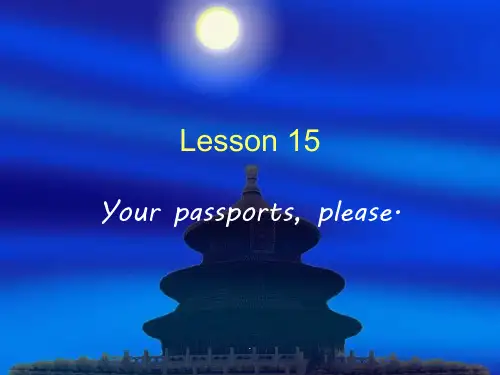


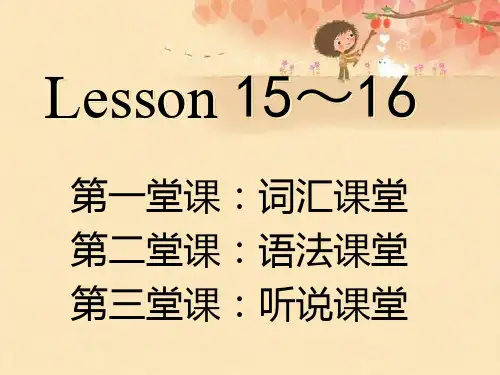
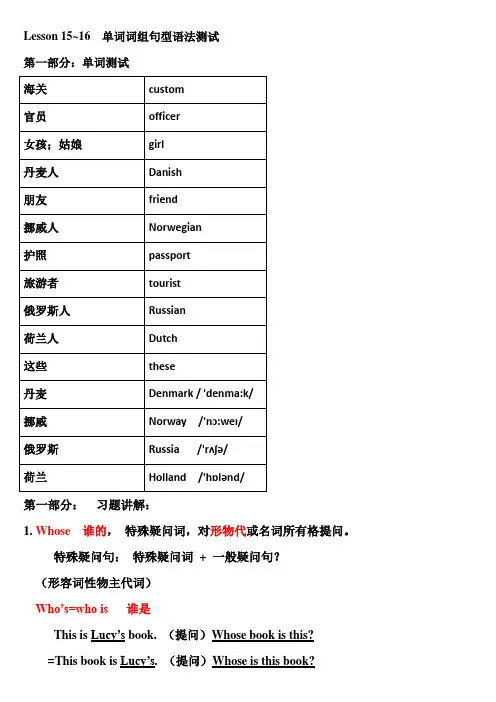
Lesson 15~16单词词组句型语法测试第一部分:单词测试第一部分:习题讲解:1. Whose 谁的,特殊疑问词,对形物代或名词所有格提问。
特殊疑问句:特殊疑问词+ 一般疑问句?(形容词性物主代词)Who’s=who is 谁是This is Lucy’s book. (提问)Whose book is this?=This book is Lucy’s. (提问)Whose is this book?① Whose is that skirt?② That car is my brother’s. Whose is that car?That is my brother’s car. Whose car is that?This is Tom’s shirt. Whose shirt is this?This shirt is Tom’s. Whose is this shirt?⑦ My hat’s new, too.My hat is new, too.it’s=it is 它是its 它的⑧ same adj. 相同的(反义词)—different adj. 不同的看起来相同look the same 在同一个班级in the same class 它是相同的颜色It’s the same colour.⑨系动词be: am/is/are “是”Lesson 13~~14 习题一、④空姐air hostess在楼上,到楼上upstairs二、上楼Come upstairs=Go upstairs.下楼Come downstairs.=Go downstairs四、Who’s =Who is 对人提问Whose 谁的对形物代(……的)或名词所有格提问30.你姐姐的新的连衣裙your sister’s new dress名词所有格表示所有关系:新的连衣裙是你姐姐的36.你的新的连衣裙your new dress39. 单数名词前必须有限定词(形物代或名词所有格)Mum’s hat is lovely.Mr. Hu is 59 English teacher. He is a good teacher. He likes Alice and Jack and they like(实义动词), too.人称代词主格: 位于动词(be)之前he she it人称代词宾格:位于动词或介词之后。
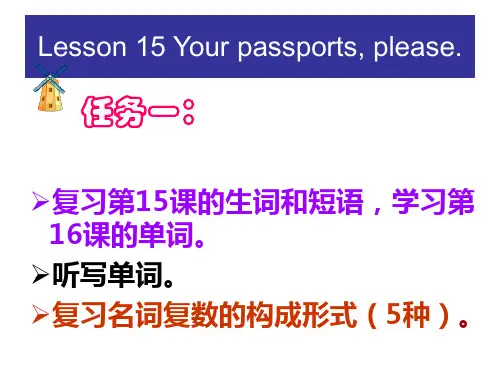
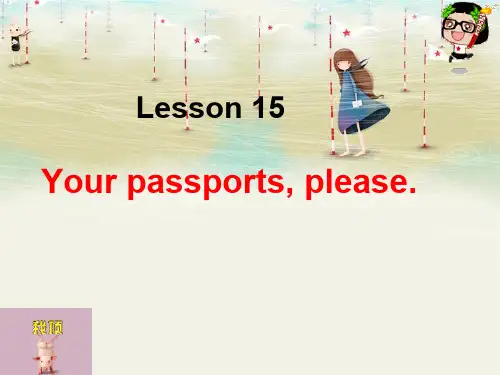
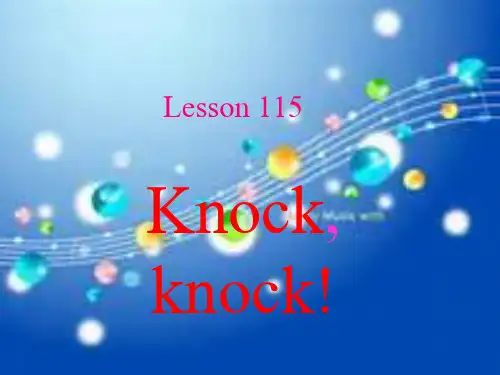
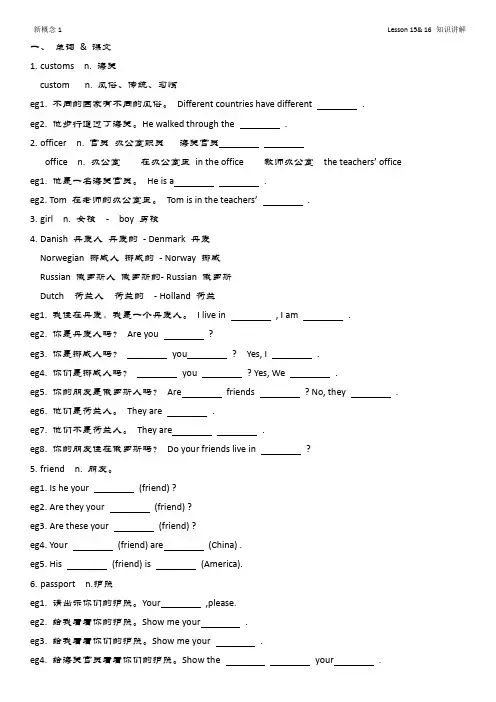
一、单词& 课文1.customs n. 海关custom n. 风俗、传统、习惯eg1. 不同的国家有不同的风俗。
Different countries have different .eg2. 他步行通过了海关。
He walked through the .2.officer n. 官员办公室职员海关官员office n. 办公室在办公室里in the office 教师办公室the teachers’ office eg1. 他是一名海关官员。
He is a .eg2. Tom 在老师的办公室里。
Tom is in the teachers’.3.girl n. 女孩- boy 男孩4.Danish 丹麦人丹麦的- Denmark 丹麦Norwegian 挪威人挪威的- Norway 挪威Russian 俄罗斯人俄罗斯的- Russian 俄罗斯Dutch 荷兰人荷兰的- Holland 荷兰eg1. 我住在丹麦,我是一个丹麦人。
I live in , I am .eg2. 你是丹麦人吗?Are you ?eg3. 你是挪威人吗?you ? Yes, I .eg4. 你们是挪威人吗?you ? Yes, We .eg5. 你的朋友是俄罗斯人吗?Are friends ? No, they . eg6. 他们是荷兰人。
They are .eg7. 他们不是荷兰人。
They are .eg8. 你的朋友住在俄罗斯吗?Do your friends live in ?5.friend n. 朋友。
eg1. Is he your (friend) ?eg2. Are they your (friend) ?eg3. Are these your (friend) ?eg4. Your (friend) are (China) .eg5. His (friend) is (America).6.passport n.护照eg1. 请出示你们的护照。
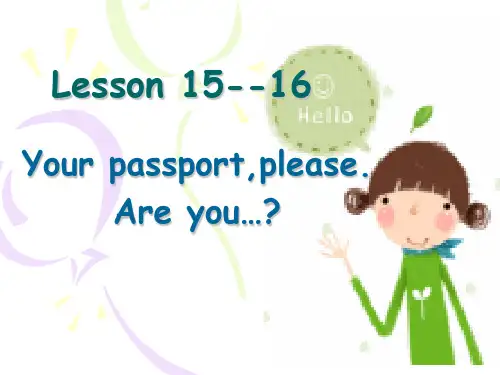
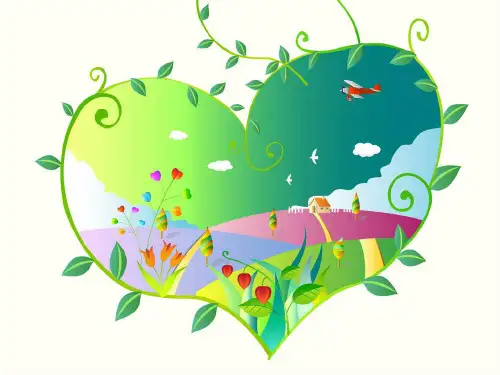
Lesson1简单句1. In private2.make conversation3.Go to the theatre4. Seat oneself5.Play+ 球类6.Play + the +西洋乐器7.Be angry with sb8.Be angry about/at sth9.Pay attention to doing10.Bear=stand = put up with11.Be born12.None of your business13.Mind your own business14.Be polite to15.Be impolite to=be rude to16.Turn round17.Be interested in18.Enjoy doing19.In the end= finally= at lastLesson2感叹句、一般现在时1.Until2.Not...until3.Outside (prep.)= out of4.Ring sb= call sb = phone sb5.Repeat oneself6.Get up7.On Sundays= every Sunday8.Stay in bed9.Look out of10.What a day!11.Just then = at that moment=at that time12.Dear me!Lesson3一般过去时1.Send sb sth = send sth to sb2.(lend/bring/give/tell/ hand/pass/sell/show/read/teach...)3.Cook/buy/make/sing/get...sth for sb4.In pubilc5.Be friendly to6.Make a (firm) decision7.The whole...= all the ....8.Single bed9.Think of10.Think about11.Think over12.Sb. spend ...on sth/in doing sth13.sth cost sb +钱14.Sb pay +钱for15.It takes sb +时间+ to do sth. Lesson 4 现在完成时1.Be excited about2.Receive/have/get sth from sb = hear from3.Be different from4.Be different in5.In the centre of6.Work for /on /in/at/out7.A number of8.The number of9.Find +n. + adj.(宾补)Lesson 5 一般过去时与现在完成时1.Leave/take/send a message2.Cover a distance in +时间3.Be covered with4.A distance of5.Request for6.Spare time7.Serve A with B8.Another9.The other10.Some ...others...11.One... the other...12.Any other13.Others14.Up to now = till now=by now15.A great many+cn.复16.In this way17.On the way18.In a way19.By the way20.In the wayLesson 61.Beg for2.Call on sb= call at sp.= visit3.Move to/out/in4.Knock at5.Ask sb for sth6.In return for this7.Stand on one’s head8.Go away9.Tell sb sbout sth10.Tell sth to sb= tell sb sth11.Once a month12. 冠词Lesson71.Expect sb to do sth2.Be valuable= be of great value3.Steal sth from sb4.Rob sb of sth5.Keep guard6.A parcel of7.The main building8.Take sth off...9.Take off10.To one’s surprise11.Be full of12.过去进行时Lesson81.neat and tidypete with3.Be made of wood=wooden4.Enter for5.Join6.Join in7.Take part in8.Go in for9. Win + 比赛/奖品10.Beat +对手11.比较级Lesson91. A cold welcome2.A crowd of3.Minute hand4.Give sb a hand = help5.Hand in hand6.Shout at/to7.Refuse to dough at 9.On Wednesday evening10.In twenty minutes’ time11.时间前的介词Lesson 101.Musical instrument2.Do damage to3.Damage4.Destroy5.Spoil6.Break7.The key to8.Allow sb to do9.Allow doing10.Get a shock11.Be made in12.Be made of13.Be made from14.Be made by15.Be made into16.Belong to17.Play jazz on the piano18.A friend of my father19.被动语态Lesson111.turn on/of/down/up2.It’s one’s turn to do sth.3.One good turn deserves another.4.Immediately=at once=right now5.Work in a lawyer’s office6.Get a good salary7.Borrow sth from sb8.Lend sth to sb9.Pay back/pay for/pay off10.To one’s surprise11.时态的复习Lesson 121.Good luck2.Lucky dog3.Sail from4.Sail for5.Sail across6.At the harbour7.Be proud of = take pride in8.It’s important for sb to do sth.9.The importance of sth10.Early in the morning11.Meet sb +地点12.Set out/off/up13.Plenty of /a great deal of /much+un.14.A great many/a number of/a crowd of/many+pl.15.A lot of /lots of +un./pl.16.一般将来时Lesson 131. a group of2.Join the club3.At present4.Give a performance5.All parts of the country6.At workers’ club7.As usual8.Have a difficult time9.Keep order10.On these occasion11.将来进行时Lesson 141.An amusing experience2.Amused3.Drive on to ...4.Ask sb for a lift5.Give sb a lift6.As soon as7.Say good morning to sb8.Apart from/Except for9.Except10.Besides11.Not ... At all12.Neither of13.Either of14.Both of15.Wave to sb16.Reply to sb17.Journey18.Trip19.Travel20.Tour21.过去完成时Lesson 151.Tell sb that2.Tell sb sth =tell sth to sb3.Tell sb sbout4.Be/feel nervous sbout/of5.Don’t be nervous= take it easy6.Afford sth7.Be good at8.Be weak /poor at9.In a weak voice10.Interrupt sb11.Pay such large salaries12.Such+n.短13.So +adj./adv.14.直接引语变间接引语。
NCE L1—L16Words1. pen pencil book watch coat dress shirt skirtsuit T-shirt blouse tie2. China-Chinese France-French Germany-German Japan-Japanese Korea-Korean Sweden-Swedish America-American Italy-Italian English-England nationality3. keyboard operator engineer policeman policewoman taxi driverpostman nurse mechanic hairdresser housewife milkman housewife air hostess4. short-long short-tall dirty-clean fat-thin hot-cold old-newold-young busy-lazy5. green red pink blue yellow brown purplesilverPatterns日常用语1.-Excuse me! -Yes?2.-Nice to meet you. -Nice to meet you, too.3.-How do you do?-How do you do?4. -How are you today? –I’m fine, thanks./I’m very well, thank you.核心句型1. This is my handbag.This isn’t my handbag.Is this your handbag?Yes, it is. / No, it isn’t.2. These are my books.Are these your books?Yes, they are. / No, they aren’t.3. What’s your job? I’m a nurse.4. What nationality are you? I’m Chinese.5. What make is it? It’s a Ford.6. What colour is your umbrella? It’s black.What colour are your umbrellas? They’re black.7. Whose handbag is this? / Whose is this handbag? It’s Stella’s.8. Are you a teacher? Yes, I am. Are you a policeman? No, I am not.知识点1.清辅音和浊辅音清辅音共12 个:[p] [t] [k] [f] [s] [θ ] [ʃ] [ts] [tr] [tʃ] [h] [r]浊辅音共16 个:[b] [d] [g] [v] [z] [ð] [ʒ] [dz] [dr] [dʒ] [l] [m] [n] [ŋ][ j ] [w]2.名词单复数形式可数名词单数在它之前可以加上冠词a/an(以元音字母a,e,i,o,u开头的字母前冠词用an)。
新概念成人版第一至第十五课知识点核心语法:1.be动词的用法;2.不定冠词a/an;3.名词的复数形式;(一)语法扩展:1.句型:主语+系动词+表语形如This is my umbrella.的句子,this作主语,is(动词be的第三人称单数现在时)为系动词,my umbrella作表语,系动词和表语一起作谓语。
主系表结构是简单句的最基本句型之一。
又如:Here is my ticket.我的票在这儿。
(这句话中,my ticket是主语,here作表语,这种句子结构被称为倒装结构。
)系表结构中的系动词除了动词be之外,还有become,feel,get,grow,look,appear, seem,smell,taste,prove等。
表语可以由名词、代词、形容词、现在分词、过去分词、不定式、副词、介词结构等充当。
例如:She became a teacher after graduation.毕业后她当了老师。
That book is hers.那本书是她的。
Her handbag is black.她的手提包是黑色的。
His speech sounds encouraging.他的讲话令人鼓舞。
Don’t get too excited.不要太激动。
Her main job was to look after the children.她的主要工作是照顾孩子。
The baby’s parents were out.婴儿的父母出去了。
The book is on the table.书在桌子上。
2.动词be的第三人称单数现在时在一般现在时中,主语为第三人称单数时,系动词要变为is.如:He is…他是…She is…她是…It is 它是…3.形容词物主代词my和your物主代词表示所有(占有)关系,又分为形容词性物主代词与名词性物主代词。
4.否定句的构成否定陈述句与肯定陈述句相反,表示“否定”某一内容,并且含有如not之类的否定词主系表的否定句通过在系动词后面加上not构成。
Lessons15-16
1.Your passports,please.请出示你们的护照。
请参见 Lessons 3~4课文详注。
2.Here they are.给您。
本句中的 they指 passports。
请参见 Lessons 11~12课文详注。
3.名词的复数形式(1)
英语中可数名词有单数和复数两种形式,指一个以上的事物时用复数形式。
可数名词的复数形式一般是在单数名词后面加上-s,如课文中的friend—friends /frendz/,tourist—tourists/'tu+rists/,case —cases/'keisiz/。
请注重-s的不同发音。
假如名词是以-s结尾的,变成复数时则要加-es,如dress —dresses/'dresiz/,blouse—blouses/'blauziz /。
语法 Grammar in use
1.表示复数的-s或-es一般遵循的发音规则
(1)假如名词词尾的发音是一个清辅音(如
/f/,
/k/,
/p/,/t/,/I/;但/s/,/M/,/tM/除外),-s发
/s/的音,如:
books/buks/
suits/su:ts/
(2)假如名词词尾的发音是一个浊辅音(如
/b/,/d/,/g/,/l/,/m/,/n/,/R /;但/z/,/N/,/DN/除外)或元音,-s发/z/的音,如:
ties /taiz/
dogs /d%26amp;gz/
(3)假如名词词尾的发音是
/s/,/z/,/M/,/N/,/tM/或/DN/,-s 发/iz/的音,如:
dresses/'dresz/
blouses/'bluziz/
词汇学习 Word study
1.blue adj.
(1)蓝色的,蔚蓝的:
The sea is deep blue.
大海呈深蓝色。
He wears a blue tie.
他打一条蓝色的领带。
(2)沮丧的,忧郁的:
He looks a bit blue.
他看上去有点儿忧郁。
His mood is blue.
他的情绪低落。
2.grey adj.
(1)灰色的,偏灰的:
His hat is grey.
他的帽子是灰色的。
(2)头发灰白的:
Her hair is grey.
她的头发灰白。
(3)面色苍白的:
Tony looks grey and tired.
托尼面色苍白,显得疲惫。
练习答案 Key to written exercises Lesson 16
A
1 It is an English car.
2 It is a Japanese car.
3 It is an Italian car.
4 It is a French car.
5 It is an American car.
6 Robert is not a teacher.
B
1 What colour are your shirts? Our shirts are white.
2 What colour are your coats? Our coats are grey.
3 What colour are your tickets? Our tickets are yellow.
4 What colour are your suits? Our suits are blue.
5 What colour are your hats? Our hats are black and grey.
6 What colour are your passports? Our passports are green.
7 What colour are your umbrellas? Our umbrellas are black.
8 What colour are your handbags? Our handbags are white.
9 What colour are your ties? Our ties are orange.
10 What colour are your dogs? Our dogs are brown and white.
11 What colour are your pens? Our pens are blue.
12 What colour are your cars? Our cars are red.。